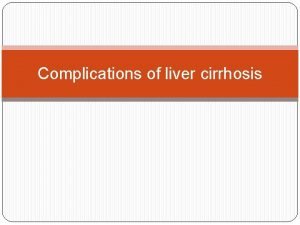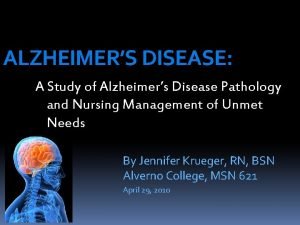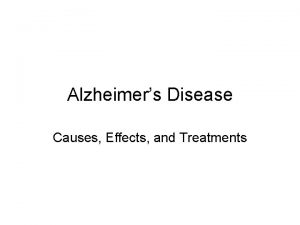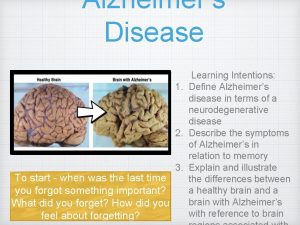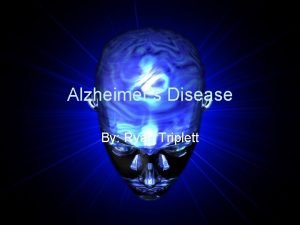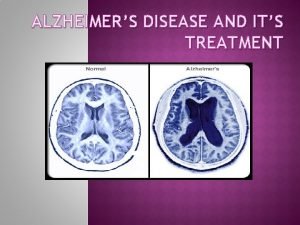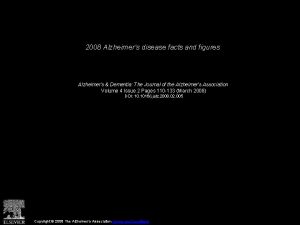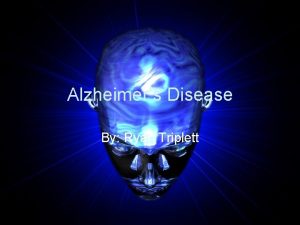WHY DOES ALZHEIMERS DISEASE AFFECT MEMORY Paragraph 1














- Slides: 14

WHY DOES ALZHEIMER’S DISEASE AFFECT MEMORY?

Paragraph 1 Researchers have acquired a deeper understanding of how memories are formed in the brain. Alzheimer’s disease—a biological condition in which memory function gradually breaks down

Beyond age 65, the risk of the disease doubles every five years—it affects nearly 50 percent of individuals over 85 Alzheimer’s disease onset is deceptively mild —in early stages the only observable symptom may be memory impairment. However, its course is one of steady deterioration.

Individuals with Alzheimer’s disease may show gradual personality changes, such as apathy, lack of spontaneity, and withdrawal from social interactions. In advanced stages, people with Alzheimer’s disease may become completely mute and inattentive, even forgetting the names of their spouse and children.

Paragraph 2 The symptoms of Alzheimer’s disease were first described in 1906 by the German psychiatrist Alois Alzheimer noted that the brains of individuals who had died from the disease contained unusual tangles of neural tissue and sticky deposits called plaques (=배양세포층의 바이러스에 의해 형성되는 국소병소)

Still, Alzheimer could not determine whether those brain changes were the cause of the disease or its products. Only in the past 15 to 20 years have researchers been able to assemble the evidence that the plaques themselves cause the brain to deteriorate.

The plaques are formed from a substance called amyloid β-peptide(Aβ). Ordinary processes in the human brain that aid in the growth and maintenance of neurons create Aβ as a by-product.

Normally, Aβ dissolves in the fluid surrounding neurons, without any consequences. However, in Alzheimer’s disease, Aβ becomes deadly to neurons: Aβ forms plaques and causes brain cells to self-destruct.

Paragraph 3 This understanding of the role of Aβ in the progress of Alzheimer’s disease has led to important recent breakthroughs. For example, researchers are beginning to improve their ability to diagnose the disease.

Human aging is accompanied by some ordinary changes in memory function. To make a timely diagnosis of Alzheimer’s disease, doctors need a way to determine whether older adults’ memory impairments are something more than ordinary change.

For most of the past 100 years that was a difficult task; impossible to see the patients’ brains while the patients were living. However, researchers have begun to develop applications of PET scans that enable them to detect the presence of Aβ in the living brain.

The key advance was the manufacture of a radioactive marker that attached itself to the Aβ plaques. This radioactive marker becomes visible through PET scans—providing a mechanism for early diagnosis of ominous patterns of Aβ in the brain.

Paragraph 4 Early diagnosis would allow early treatment, with the goal of minimizing the negative impact of the disease. Preventive measures and treatments: several lines of research focus on Aβ. For example, researchers are seeking methods to interrupt the biochemical processes that produce Aβ in the first place.

They are also exploring techniques to destroy the Aβ plaques once they have begun to form. Taken together, these approaches hold out great hope that Alzheimer’s disease will be less devastating for future generation.
 Does music affect your memory
Does music affect your memory Pictures
Pictures Hi
Hi Georgia alzheimers planning
Georgia alzheimers planning Fast score dementia
Fast score dementia Alzheimers sjukdom
Alzheimers sjukdom Alzheimers nz conference 2020
Alzheimers nz conference 2020 Site:slidetodoc.com
Site:slidetodoc.com Alzheimers society contented dementia
Alzheimers society contented dementia Alzheimers eye test joke
Alzheimers eye test joke Why does liver disease cause splenomegaly
Why does liver disease cause splenomegaly Factors that affect disease transmission
Factors that affect disease transmission Communicable disease and non communicable disease
Communicable disease and non communicable disease Dont ask
Dont ask Episodic memory vs semantic memory
Episodic memory vs semantic memory










